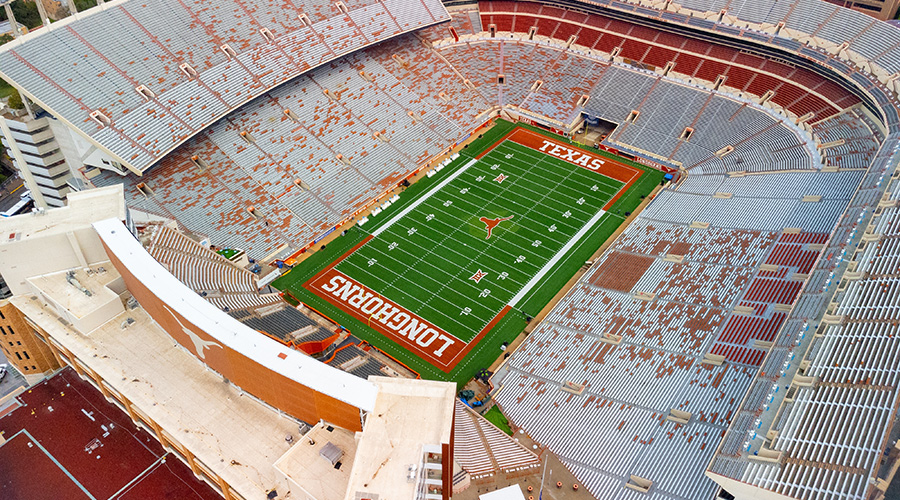Facilities ‘Arms Race’ in College Athletics Shows no Signs of Slowing

As more money infiltrates college sports, athletic departments continue spending sprees on upgrades
College sports are undergoing a dramatic transformation.
Athletes are experiencing more freedom than ever before, with the development of the transfer portal and the ability to move from school to school with no repercussions. The emergence of name, image and likeness (NIL) is enabling student-athletes to profit from their abilities on the field or court.
And an influx of network television money has changed the structure of big-time college athletics, triggering conference realignment, expanded college football playoffs and the likely eventual expansion of the NCAA basketball tournament.
The television funds are trickling down through athletic departments to help fund several initiatives. Among the most prominent of those investments are facilities. Colleges and universities across the country are spending millions to upgrade their stadiums and athletic complexes to keep fans and donors happy and hopefully attract the next great quarterback or point guard to come play for their school.
“I think what’s driving it is an ever-sophisticated consumer,” says Michael Hessert, partner and technical director of PBK Sports, a division of the national architecture firm PBK, which has worked on higher education projects at schools such as the University of Texas, Texas A&M University and the University of Houston. “Athletic fans and spectators, what they see at the pros, they now expect to see an experience similar at lower levels of athletic competition.”
The fan experience
Television can give athletic programs increased exposure and revenue, but it can also take away from the universities. As ticket costs rise continue to rise, more fans are opting to watch the games at home on television, where the bathroom is only a short walk away from the couch, cold beer and snacks are in the refrigerator and at a fraction of their cost at the concession stands without the hassle of parking and driving to the venue.
To help combat the changing fan trends, more universities are adjusting their in-stadium experience to accommodate the trend in hopes of increasing revenue and boosting the fan experience. In some instances, that “boost” includes reducing the seating capacity in addition to providing expanded customer experiences and other entertainment amenities such as more interactive and expanded video boards.
“It’s a broader diversity of options, such as different seating types,” Hessert says. “One of the things we find, especially in renovations, is that with the exception of a handful of schools where they have a fan base where they need to get bigger, a lot of places are reducing capacity and exchanging those seats for a broader diversity of seating types.
“It ends up driving more revenue if you can exchange a handful of $50 seats for each game and translate that space into loge boxes or additional club or suite seats with amenities. You can drive that price point up.”
Another important part of the fan experience is improving the in-stadium Wi-Fi. Fans inside many football stadiums often struggle to get cell phone access, vitally important to fans who are checking on game statistics or other contests, following reactions on social media, and in what’s becoming more common, in-game gambling.
“Developing content, whether it be team-based apps or those kinds of things, we’ve tried as an industry to do those throughout the years,” Hessert says. “That’s still going to be an endeavor, trying to use those devices folks already have. In today’s society, we’re so connected to these things, and they’ve become such an integral part of our lives.”
Appealing to athletes
The “arms race” that Hessert describes in college sports extends beyond the seats and concession stands and spills over to the athletes themselves.
Recruiting has always been the lifeblood of college sports, as the best players will pick the best schools to play at based on factors of which the quality of facilities is among them. In addition to wondering about coaches, playing time and academic majors, players are taking deeper looks at the amenities available to them at schools as many try to reach the professional level.
Eight-and-nine figure upgrades are common in today’s college atmosphere. The upgrades include state-of-the-art locker rooms such as the University of Oregon’s that includes marble showers and Ferrari leather chairs.
“Everything trickles down from the pros,” Hessert says. “We’re seeing sports medicine type things, such as hydrotherapy pools, resistance training and treadmill pools, and things associated with player safety and player performance.”
Hessert is also finding out that lavish upgrades are extending down to the high school level, where school districts are investing heavily in their athletic programs in the chase for championships.
No matter what level an institution, Hessert suggests that the facilities team have a clear plan of what they want to build, and how to achieve it.
“Understand where you want to go, and then follow a plan,” he says. “Adjust as you need to. So many folks do a project, they start doing stuff, and after the fact you come to find out that had we done this a little bit differently, it wouldn’t be costing us some extra amount of money on our next project.”
By Dave Lubach, Executive Editor
Dave Lubach is the executive editor of the facilities market. He has more than nine years of experience writing about facility management and maintenance issues.
The post "Facilities ‘Arms Race’ in College Athletics Shows no Signs of Slowing" appeared first on Building Operating & Management

